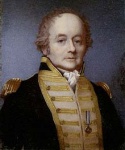In accord with the Drome who produce biographies of the leading pilots of the era, I am about to embark on a series of posts reflecting on the famous Naval personalities of our period here on the Anchorage. Because it is a large undertaking, I decided to begin with the Battle which Sven is putting on at Doncaster this year.
Firstly the British Captains. Nelson's band of brothers.
Nelson's Band of Brothers.
The Nile Campaign.
Commander Ship Notes Capt. Edward Berry Vanguard Nelson's flag captain Capt. Alexander Ball Alexander Capt. Davidge Gould Audacious Capt. Henry D'Esterre Darby Bellerophon Capt. Thomas Troubridge Culloden Capt. John Peyton Defence Capt. Thomas Foley Goliath Capt. George Blagdon Westcott Majestic Killed during the battle Capt. Thomas Louis Minotaur Capt. Sir James Saumarez Orion Nelson's second in command Capt. Benjamin Hallowell Swiftsure Capt. Ralph Willet Miller Theseus Capt. Samuel Hood Zealous Capt. Thomas Boulden Thompson Leander Lt. Thomas Hardy Mutine
Rob.







 Reply With Quote
Reply With Quote
Bookmarks